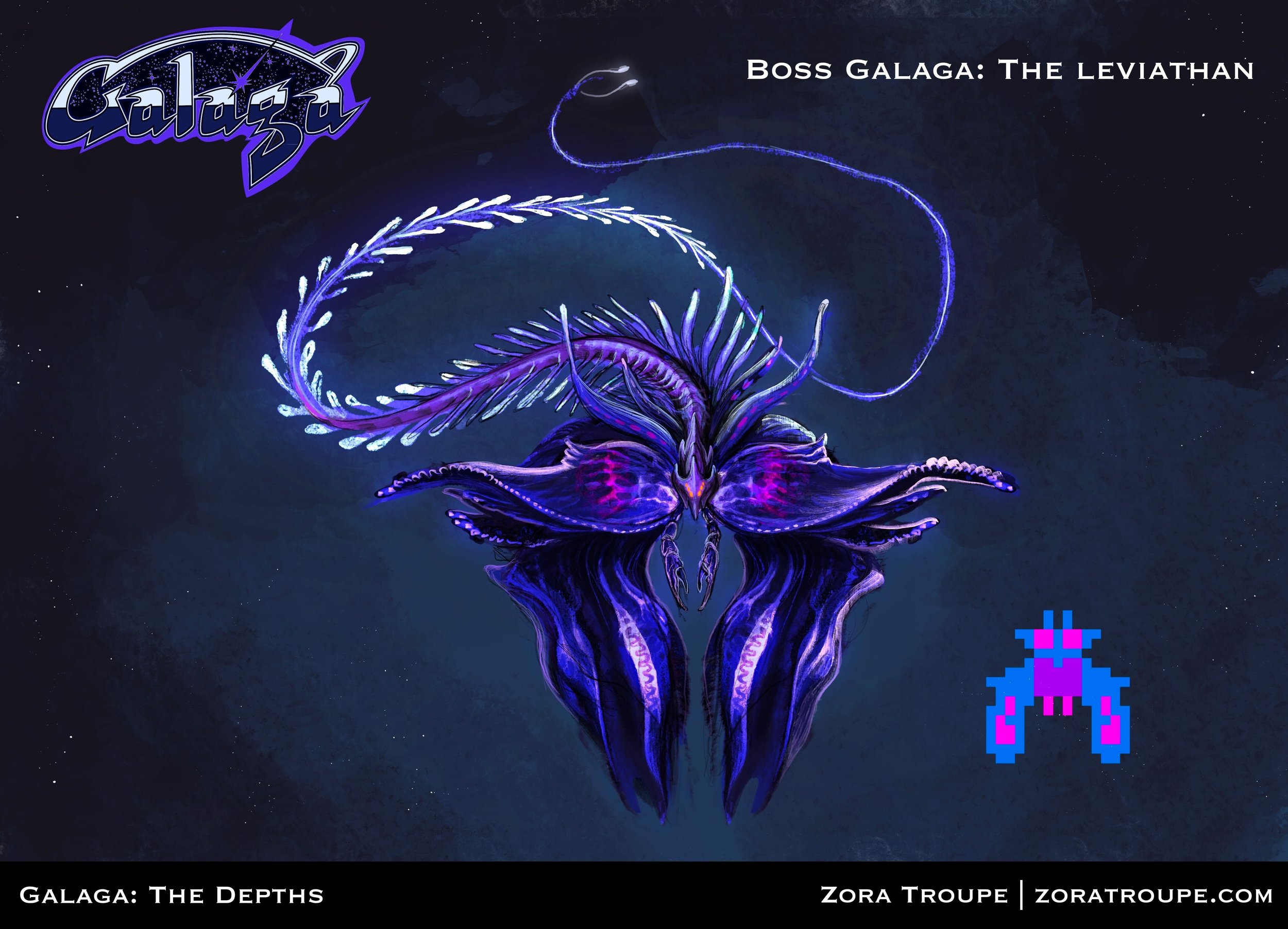Alien Design Exploration
For the past two weeks, our advanced concept art class has been diving deep into the alien forces of Galaga, reimagining the iconic foes that have swarmed arcade screens for decades. The challenge? Strike a careful balance between nostalgia and originality—and the results have been bold, inventive, and increasingly refined.
The classic Galaga enemy hierarchy provided our design foundation:
Grunts (Zako) – The baseline threat, appearing in high numbers with simple dive patterns.
Guards (Goei) – Mid-level enemies with more coordinated formations and multiple projectiles.
Boss Galaga – The most iconic enemy in the series: durable, fly-like leaders equipped with multi-shot attacks and a tractor beam that can capture the player’s ship and turn it against them.
These behavioral traits—like the Boss Galaga’s two-hit durability, escort behavior, and conditional tractor beam use—have been front-of-mind as students crafted visual identities that feel grounded in gameplay mechanics.
Here are a few key takeaways from our recent critiques and class discussions:
Nostalgia + Originality
While many students are leaning toward fresh interpretations, we’re seeing more intentional callbacks to the original sprites—sometimes subtly, sometimes boldly.
Equal Visual Weight for Sprites
Rather than hiding the original pixel sprites, we're emphasizing side-by-side comparisons to showcase each design’s evolution and connect more directly with player nostalgia.
Consistent Scale = Clear Communication
When presenting multiple character types (Boss, Guard, Grunt), we stress keeping all designs at a consistent scale. This helps avoid confusion—especially for non-artist viewers or stakeholders unfamiliar with concepting shorthand.
Color as a Nostalgia Lever
Several students are now exploring more saturated, arcade-inspired palettes that instantly recall Galaga’s vibrant 8-bit energy.
Echoing Pixel Design Language
Designs for the Boss Galaga in particular have benefited from referencing legacy elements—like the original wing markings—to signal identity while keeping the visual language fresh.
Emerging Factions & Backstories
We’re also seeing strong storytelling emerge through visual design. Students are developing factions and character dynamics that add depth and variety to their reimagined alien forces.
Sophie Sala has reimagined the classic Boss and Goei as a duo from ARMADA Racing—a ruthless, high-speed alien racing team. Boss is the stoic, unbeatable veteran; Goei, the scrappy and mischievous rookie. Together, they bring a fierce competitive energy to the enemy lineup.
Bee Lawhorn transforms the Boss Galaga into a more ambient, exploratory threat—an alien you might encounter while drifting through space, seemingly passive until provoked. Inspired by bioluminescent sea life, Bee’s design glows with subtle menace, emphasizing a “harmless-until-aggroed” tension that adds mystery and mood to the encounter.
Rana Barua tackled redesigns of the Boss Galaga, Goei, and the Galagian Flagship. While the Boss and Goei lean into classic bug motifs with an alien twist, Rana’s take on the flagship veers in a completely different direction, breaking from expectations to introduce bold contrast within the same faction.
Krow Zhang stayed true to the original formation of the Boss Galaga and Goei but added a fresh gameplay twist: the Boss Galaga now has two phases. Once its initial form is defeated, it sheds its shell and reemerges as a larger, more elegant threat, escalating the stakes mid-fight and giving the classic enemy a new sense of drama and transformation.
Grace Doeller presents a Boss Galaga as a translucent, bioluminescent leviathan, influenced by sea angels, jellyfish, praying mantises, and moths. This massive entity devours entire worlds by unleashing coordinated swarms of Zako and Goei, blending grace and horror into a singular, haunting presence in deep space.
Bea Parlade envisions a mutated Boss Galaga, deteriorated over time and left behind on a fallen planet. Twisted by decay and isolation, this version haunts the landscape, terrorizing the few surviving humans who remain. It’s a dark, post-collapse interpretation that reframes the enemy as a symbol of lingering devastation.
Rachel Liu introduces a mysterious, silent insectoid based on the orchid mantis and venus flytrap—predators of other insects. This figure possesses the eerie ability to control the Galaga themselves, suggesting a hidden hierarchy behind the swarm. Elegant yet dangerous, Rachel’s design adds a layer of intrigue to the enemy structure.
Zora Troupe builds a full multi-phase encounter around the Boss Galaga, drawing inspiration from deep-sea organisms. The Boss features large fins and vibrant color shifts—moving from sage greens to deeper blues and purples as it takes damage. The fight ultimately culminates in the reveal of The Leviathan: a massive creature that has absorbed traits from all Galaga enemy types, forming a single, towering, hybridized organism.
More student factions and narrative twists are coming in as designs evolve—stay tuned for even more inventive takes on the Galaga universe.
What’s Next: The Key Image
With our enemy faction designs wrapping up, we’re excited to transition into our next major assignment: the KEY IMAGE.
Over the next three weeks, students will concept and execute a primary marketing image for their Galaga IP. Think:
The movie poster
The book cover
The hero splash screen
This image will distill the world, tone, and drama of their version of Galaga into a single compelling frame.
Save the Date: MICA Showcase
We’re also proud to announce that work from Galaga Reimagined will be on display at MICA!
April 14 – May 9
Top floor, Fox Building
The show will feature highlights from across the semester, including alien designs, ship concepts, faction development, and final Key Images. We’re thrilled to be sharing this work with the broader MICA community—make sure to swing by and check it out!















